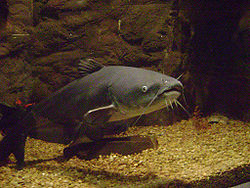
Interactions & Reproduction
Because of their large size and great reputation of delicous food, the Blue Catfish has become a very popular sport fish. Since the average length is between 20 and 45 inches and can grow up to 65 inches, these fish have been considered trophy fish and are sought after by people from over 30 states in the United States (Kristopher & Shoup 2010). Lots of other stats and facts on Blue Catfish can be found here.
Catfish are not only important because of their ability to produce food, but they are also important to the scientific community. They represent a long-lasting research model and greatly help scientists study things such as new strains of diseases and infections that affect fish. A big reason why catfish are a great candidate for scientific studies is the fact that there is a vast variety of Catfish all over the world (Chao, Beck, Su, Terhune & Peatman 2013).
The Catfish spawn occurs in late spring and early summer. Blue Catfish prefer to lay their eggs in about 70 to 75 degree water and lay these eggs in very secluded areas. These places include holes in logs, brush piles, caves in rocks and soil or under the river bank of lake shore. When it comes to most species of Catfish, after the eggs are laid, the female will leave the nest to fee and the male will guard the nest. But in the case of the Blue Catfish, both the male and female stay and guard the nest.
 Courtesy:
Wikipedia 2013
Courtesy:
Wikipedia 2013